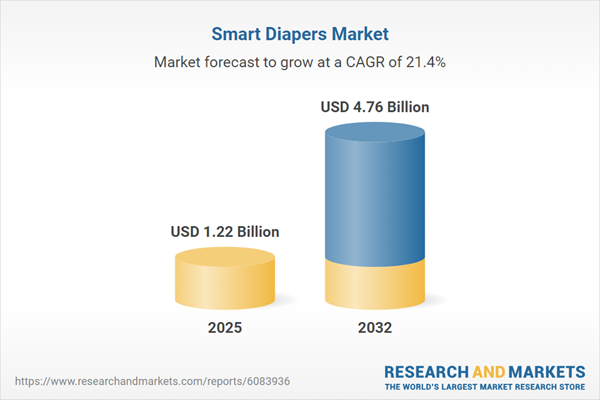Speak directly to the analyst to clarify any post sales queries you may have.
The smart diapers market is poised for significant transformation, driven by advanced sensor technology, heightened demand across multiple care settings, and evolving global care requirements. Key innovations in connectivity, analytics, and real-time monitoring are reshaping care delivery and operational efficiency for healthcare providers and caregivers alike.
Market Snapshot: Smart Diapers Market Growth and Dynamics
The Smart Diapers Market grew from USD 1.01 billion in 2024 to reach USD 1.22 billion in 2025, sustaining a CAGR of 21.37% and forecasted to reach USD 4.76 billion by 2032. Growth stems from the intersection of intelligent hygiene solutions and healthcare technology, propelling adoption in hospitals, homecare, and long-term care facilities. Regulatory changes and digital health integrations underpin market momentum, while strategic investments in research and local supply chains address shifting consumer and institutional needs.
Scope & Segmentation
- Product Type: Disposable (premium, standard); Reusable (silicone insert, washable).
- Technology: Leak detector; Multi-sensor (temperature and motion, wetness and motion, wetness and temperature); Temperature sensor; Wetness sensor.
- Distribution Channel: Hospital (elderly care, neonatal); Online (company website, e-commerce marketplace); Retail (hypermarkets and supermarkets, pharmacies, specialty stores).
- End User: Adult senior, infant, toddler.
- Connectivity Type: Bluetooth (BLE, classic); NFC; Wi-Fi (802.11ac/ax, 802.11b/g/n).
- Sales Model: Single-use, subscription (annual, monthly, quarterly).
- Regions: Americas (North America: United States, Canada, Mexico; Latin America: Brazil, Argentina, Chile, Colombia, Peru); Europe, Middle East & Africa (Europe: United Kingdom, Germany, France, Russia, Italy, Spain, Netherlands, Sweden, Poland, Switzerland; Middle East: United Arab Emirates, Saudi Arabia, Qatar, Turkey, Israel; Africa: South Africa, Nigeria, Egypt, Kenya); Asia-Pacific (China, India, Japan, Australia, South Korea, Indonesia, Thailand, Malaysia, Singapore, Taiwan).
- Key Companies: Kimberly-Clark Corporation, Procter & Gamble Company, Essity Aktiebolag (publ), Ontex Group NV, Unicharm Corporation, Kao Corporation, Hengan International Group Company Limited, Dryad Diapers Ltd.
Key Takeaways: Insights for Senior Decision-Makers
- Sensor-enabled diapers move beyond traditional hygiene, enabling proactive care through real-time monitoring of moisture, temperature, and movement.
- Healthcare and caregiver efficiency improves with integration into electronic health records and mobile application platforms, supporting timely interventions.
- Artificial intelligence and machine learning empower predictive analytics, guiding personalized care regimens and reducing skin complication risks.
- Emerging business models, such as tiered subscriptions, support scalability for institutions serving diverse populations and care environments.
- Regional differences require tailored market entry strategies, with adoption propelled by local reimbursement frameworks, regulatory harmonization, and infrastructure readiness.
- Partnerships across materials science, sensor innovation, and analytics are essential for technology differentiation and supply chain resilience.
Tariff Impact: Navigating Regulatory Change in the US
The United States’ 2025 tariff schedule on imported medical and hygiene products is reshaping procurement and cost structures. Manufacturers are diversifying sourcing, localizing critical sensor assembly, and optimizing logistics to maintain competitive pricing. Collaboration across procurement, manufacturing, and distribution has become essential for safeguarding both supply continuity and profitability.
Methodology & Data Sources
This research applies a hybrid methodology, combining primary interviews with healthcare professionals and end users, structured workshops with developers, and secondary analysis of industry publications, regulatory filings, and patent databases. Quantitative data includes device usage logs and warranty records, validated through comparative benchmarks and expert reviews.
Why This Report Matters
- Enables strategic planning, giving stakeholders actionable insights into evolving technologies, market segmentation, and adoption patterns for the smart diapers market.
- Assists decision-makers in navigating supply chain complexity and regulatory shifts to maintain operational efficiency and sustainable growth.
- Supports competitive benchmarking and partnership strategies by detailing regional trends and highlighting key industry players.
Conclusion
The smart diapers market combines sensor integration, data analytics, and healthcare connectivity to meet the evolving needs of modern care environments. Organizations that align with regulatory changes, invest in digital innovation, and leverage collaborative alliances will drive ongoing value and industry leadership.
Table of Contents
3. Executive Summary
4. Market Overview
7. Cumulative Impact of Artificial Intelligence 2025
List of Figures
Samples

LOADING...
Companies Mentioned
The key companies profiled in this Smart Diapers market report include:- Kimberly-Clark Corporation
- Procter & Gamble Company
- Essity Aktiebolag (publ)
- Ontex Group NV
- Unicharm Corporation
- Kao Corporation
- Hengan International Group Company Limited
- Dryad Diapers Ltd.
Table Information
| Report Attribute | Details |
|---|---|
| No. of Pages | 188 |
| Published | October 2025 |
| Forecast Period | 2025 - 2032 |
| Estimated Market Value ( USD | $ 1.22 Billion |
| Forecasted Market Value ( USD | $ 4.76 Billion |
| Compound Annual Growth Rate | 21.3% |
| Regions Covered | Global |
| No. of Companies Mentioned | 9 |









